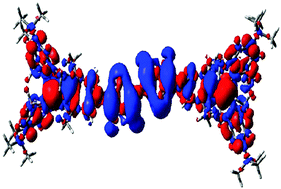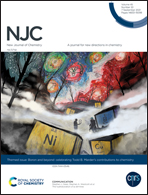Two-photon absorption of dipolar and quadrupolar oligothiophene-cored chromophore derivatives containing terminal dimesitylboryl moieties: a theoretical (DFT) structure–property investigation†‡
Abstract
A series of dipolar and quadrupolar dimesitylboryl (BMes2) derivatives containing different thiophene oligomers as the central conjugated bridge to which BMes2 substituents are appended at both ends have been investigated theoretically via density functional theory (DFT) and time-dependent (TD) DFT calculations. The results indicate that for all quadrupolar compounds studied the excited state reached by the two-photon absorption (2PA) is the S2 state which is one-photon forbidden and which corresponds to the HOMO to LUMO+1 electronic transition. When the terminal alkene (double) bonds in the nV species, containing n thiophene rings in the conjugated bridge, are replaced by alkyne (triple) bonds, giving the nT compounds, an increase of the 2PA cross-sections is always stated. Modification of the conjugated linker and addition of trimethylammonium (NMe3+) substituents to the phenyl rings of the terminal BMes2 moieties show two 2PA peaks at different wavelengths with the low energy one corresponding to the population of the S2 excited state and the second one corresponding to the population of a higher excited state. Substitution of the NMe3+ groups by neutral electron-attracting cyano (CN) groups shows lower 2PA cross-sections.

- This article is part of the themed collection: Boron & Beyond - in celebration of Todd Marder


 Please wait while we load your content...
Please wait while we load your content...